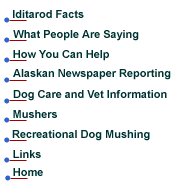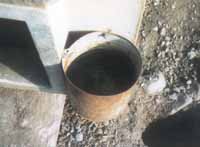

More Veterinary Information
A majority of Iditarod veterinarians belong to the International Sled Dog Veterinary Medical Association (I.S.D.V.M.A.), a group which, according to its membership materials, has "furthering the cause of the sport of mushing" as a main objective. This creates a conflict of interest, because mushing often endangers the health and sometimes the life of these dogs. The International Sled Dog Veterinary Medical Association's involvement includes:
• Sponsoring the Iditarod
• Endorsing permanent tethering as a "preferred" method of confining dogs although animal protection groups and the United States Department of Agriculture have determined this practice to be "inhumane." The permanent chaining of dogs is prohibited in all cases when federal law applies.
 |
| Dogs drink water containing flakes of rust. |
• Having members who have accepted funds for their research from the Iditarod Trail Committee
• Having members who act as veterinary volunteers during the Iditarod, thereby saving the Iditarod Trail Committee thousands of dollars and enriching the prize pot
• Having members who accept money for their participation in the race and who accept gifts such as free hotel rooms and rental cars from race sponsors
• Having mushers among its membership, including at least one that markets mushing and the Iditarod to schoolchildren (Sonny King, DVM)
• Reserving voting privileges for "veterinarians with trail experience on recognized sled dog races," thereby making it difficult for veterinarians who oppose mushing to be involved in policy decisions
• Encouraging the media to compare dogs to human athletes to explain "sudden death" among dogs in the Iditarod
• Providing pro-Iditarod statements to the press to lessen the impact of dog deaths and injuries on public opinion
• Inviting any non-veterinarian "who supports our objectives and wishes to encourage our efforts" to become members
The
Iditarod veterinarians who are also I.S.D.V.M.A. members are not independent
and objective observers and protectors of dog welfare. Instead, they are
people with a strong allegiance to the mushing community and the Iditarod.
Reasons
why International Sled Dog Veterinary Medical Association members support
the Iditarod:
Dr. Paula Kislak:
"The veterinarians who belong to the International Sled Dog Veterinary
Medical Association are industry veterinarians, basically. They're a small
group of veterinarians whose livelihood is supported by the industry of
dog sled racing. So, they may or not be corrupt, but they're certainly
very much invested in believing that what they're doing is OK, and invested
literally, financially, as well as emotionally in promoting it. But they
do constitute a small percentage of veterinarians that think this is OK."
- Dr. Paula Kislak, DVM, is president of the Association
of Veterinarians for Animal Rights.
- Her remarks were made on the Animal Voices radio show, Toronto, Canada
on February 28, 2006
Information
on poor veterinary care
Race veterinarians provide pro-Iditarod statements that are part of a strategy of promoting mushing and portraying it in a favorable light. This strategy is outlined below:
• Absolve the Iditarod Trail Committee and mushers of blame for dog deaths by attributing deaths to mysterious causes or susceptibilities. Never intimate that the stress and exertion of running might be factors.
• Encourage people to think of sled dogs as being similar to human athletes.
• Raise no questions about how the dogs are treated in their kennels or during the Iditarod.
• Stress that the number of dogs who die in the Iditarod is the same as the number who die under less arduous conditions.
• Praise mushers for their dog care, without mentioning that mushers are neglecting or abusing their dogs.
• Tell the media that additional tests will be done on dead and injured dogs and do not mention when the test results will be available. This delay encourages people to think the causes are very difficult to determine, while avoiding the issues of overexertion and abuse as causes of death and injury. It allows veterinarians to present no results or to claim that no causes could be determined. Most importantly, it allows the positive hype about the race to continue without the public learning the specifics of dogs deaths and injuries.
Information
on poor veterinary care
Dog Care Needs Improvement
1. In order to better diagnose heart problems, the Iditarod Trail Committee (ITC) should require each dog to have an electrocardiogram a week before the start of the race.
2. The Official Iditarod Race Rules do not require all dogs to have physical examinations by veterinarians during the Iditarod. Dog deaths and injuries would decrease if they were given complete physicals at every checkpoint.
3. Within five days before the start of the race, each dog should be required to have a complete blood work-up, chest x-rays and a urine test.
4. The Iditarod Trail Committee does not require that mushers be certified in first aid for dogs or in canine CPR. These certifications should be made a requirement.
5. During the race, mushers are required to rest their dogs for only one twenty-four hour period and two eight-hour periods. The ITC should require many more eight-hour rest stops.
6. The Iditarod Trail Committee should set minimum veterinarian to dog ratios, so that all dogs receive complete and high quality physical exams at the checkpoints. The ITC Dog Care Measures calls for a staff of approximately 35 veterinarians, including approximately five novices. This is inadequate, because as many as 1,000 dogs can go through each of the 24 (as of the year 2000) checkpoints at all hours of the day and night.
Iditarod vet's dog races in the Iditarod
"The Golden Stethoscope Award, given to a veterinarian
deemed most helpful by the mushers, was claimed also by a Norwegian. Ingrid
Wiik Haugbjørg's tireless energy and willingness to help at the Nome dog
lot was recognized. Like all Iditarod veterinarians, Haugbjørg is a volunteer.
Interestingly, Hagbjørg had a dog in this year’s race. Bjørnar Andersen,
fourth place, ran one of her dogs."
- Jon Little, Cabela's Iditarod website, March 21, 2005
-
Little formerly wrote for the Anchorage Daily News
How
much of a "vet check" is actually done by a vet? Are they done
too quickly?
"Dog
after dog paraded past [Bob] Sept, a former Iditarod chief veterinarian,
and now the operator of the Bering Sea Animal Clinic in Anchorage, for
quick physicals. Sept and his assistants examined eyes, ears, mouths,
abdomens, and feet."
- Lew Freedman, Anchorage Daily News, March 2, 1989
Veterinarian refers to a dog as an inanimate object:
Veterinarian
Jim Brick speaking about a dog named Yellowknife: "It
was labored breathing. It had a temperature. It had been on IV fluids
and it had been on IV antibiotics."
- Alaska Public Radio Network, website, March 10, 2006
(Yellowknife subsequently died.)
"'Some
of these little dogs, they're like a little machine...' he [Mike Yacapraro]
said"
- Mike Yacapraro is a veterinarian
- Chris Kick, The Daily Record, March 31, 2007
Iditarod
veterinarians violate oath:
Janice
Blue:
"I have to ask what is the code for veterinarians in animal medicine?
What are you supposed to be, what is your mission, or oath that you all
take? Because aren't there veterinarians at these checkpoints? And how
are they allowing this to happen?"
Dr. Paula Kislak: "Well that's a good question.
Of course, the oath that we take is primarily like human medical doctors
to above all do no harm and to protect the well being, and health and
welfare of the animals. And that's impossible to do under these circumstances.
There are no requirements for checkups. Some of the mushers stop at checkpoints
for less than five minutes, and there are multiple dogs and multiple mushers,
and there's no way that a single veterinarian that may be at a checkpoint
would be checking these animals up. There's no requirement to do so, and
it obviously isn't done, given the fact that the mushers may be there
five minutes or less, and they may have eight or 10 dogs, and there may
be many mushers. So, that's just a physical impossibility. It's not being
done and it's not being required to be done, so the welfare of the animals
is not being looked after."
-
Janice Blue is the host of the radio program Go Vegan Texas, KPFT
- Dr. Paula Kislak, DVM, is the president of the Association of Veterinarians
for Animal Rights
Veterinarian
doesn't want people to see dead dog:
"Because
the Safety checkpoint is only about 20 miles from Nome, there were also
a lot of spectators standing around watching. The vet really didn't want
to unload a dead dog from the sled in front of that crowd, [Mark] Nordman
said."
- Mark Nordman is the race marshal
- Craig Medred, Anchorage Daily News, March 18, 2007
[The dead dog was Ramy Brooks' dog Kate. He transported her body to Nome.]
Ed
Iten races sick dogs and gets vet's Humanitarian Award:
"Considering
his dogs struggles with diarrhea from Day 2 of the Iditarod all the way
to his 24-hour stop in the ghost town of Iditarod, he's [Ed Iten's] pleased.
'I saw my first turd today,' he said."
- Kevin Klott, Anchorage Daily News, March
11, 2007
[The 2007 Iditarod started on March 3.]
[After the 2007 Iditarod, the veterinary staff gave Ed Iten its Humanitarian
Award.
- Iditarod website, 2007]
Veterinarian
doesn't suggest pulling sick dogs from race:
"Their
diarrhea had not improved and I could tell they were not as healthy as
at the start of the race. Although they drank as much as the other dogs
they were becoming dehydrated. If the medication did not kick in, they
would begin to lose weight and the physical strain of running would take
them down even faster. I was concerned enough that I called the veterinarian's
attention to it. He gave me more medication."
Scdoris,
Rachael and Steber, Rick. No End in Sight: My Life as a Blind Iditarod
Racer, New York: St. Martin's Griffin, 2007
More
information on poor veterinary care
|
|
Mushers | Recreational Mushing | Links | Home A Kid's Thoughts |
Receive action alerts and contact SDAC: [email protected]
PO
Box 562061
Miami, FL 33256
The SDAC does not raise money and does not accept funds. Its efforts are completely volunteer-based.
© 2008 SDAC